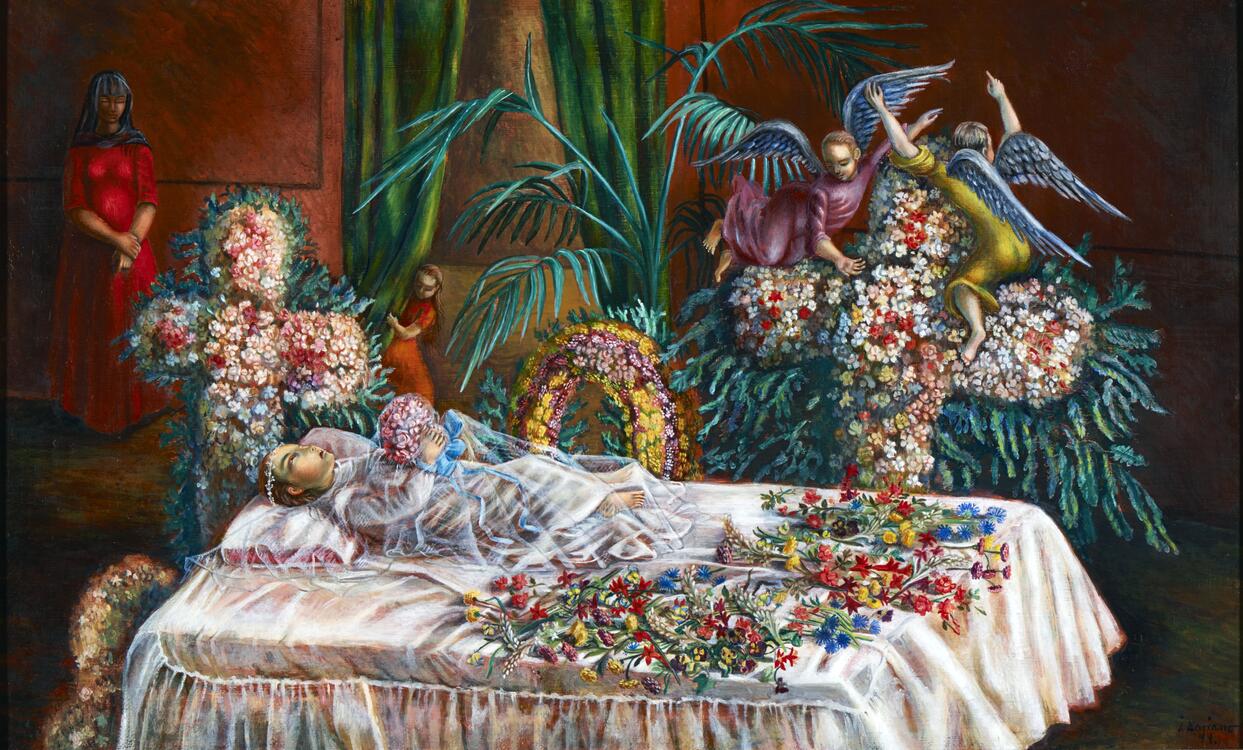La Niña Muerta / Juan Soriano
Gallery Label
Artist Juan Soriano observed post-mortem paintings while growing up in Guadalajara, though they fell from popularity by the early twentieth century. As an adult, he witnessed scenes of deceased children surrounded by flowers and candles, laid out in the open windows of their homes in the small villages of Veracruz. This painting (along with several others) was inspired by these memories.
Toward the upper right of this painting, the presence of angelitos suggests that the child will soon join the winged cherubs as guardian angels and may also refer to another folk tradition, Day of the Dead. On this day, the souls of children (also called angelitos), are welcomed back to join the living. In the background, the sorrowful face of a woman and a young child peeking around a curtain remind us of the mourning that surrounds such a loss.
Curiously, an unfinished portrait of a man in a suit is on the back side of this painting. Rendered in a completely different style, this portrait reveals the artist’s range as a painter and perhaps his thriftiness as well.
El artista Juan Soriano observaba cuadros de inspección post-mortem mientras crecía en Guadalajara, aunque ya para principios del siglo XX la popularidad de ese género había caído. Como adulto, presenció escenas de niños occisos rodeados por flores y velas, tendidos en las ventanas abiertas de sus casas en los pueblos de Veracruz. Tales memorias inspiraron este cuadro, entre algunos otros.
Hacia el lado derecho hasta arriba, la presencia de los angelitos sugiere que esta niña pronto se unirá a los querubines alados como ángeles de guarda, y tal vez se refiera también a otra tradición folklórica, el Día de los Muertos. En este día, las almas de los niños (también llamados angelitos) se reúnen, bienvenidos, con los vivos. En el fondo, el rostro lleno de angustia de una mujer, y un niño que espía desde detrás de una cortina, nos recuerdan el luto que permea tal pérdida.
Curiosamente, un retrato sin acabar de un hombre en traje ocupa el reverso de este cuadro. Interpretado en un estilo completamente diferente, el retrato revela la gama artística del pintor, y quizá también su frugalidad.
From the exhibition: Mexican Modernism: Revolution & Reckoning, August 29, 2019 - August 30, 2020.
Alison Rossi, Director of Learning and Community Engagement, 2019.
Toward the upper right of this painting, the presence of angelitos suggests that the child will soon join the winged cherubs as guardian angels and may also refer to another folk tradition, Day of the Dead. On this day, the souls of children (also called angelitos), are welcomed back to join the living. In the background, the sorrowful face of a woman and a young child peeking around a curtain remind us of the mourning that surrounds such a loss.
Curiously, an unfinished portrait of a man in a suit is on the back side of this painting. Rendered in a completely different style, this portrait reveals the artist’s range as a painter and perhaps his thriftiness as well.
El artista Juan Soriano observaba cuadros de inspección post-mortem mientras crecía en Guadalajara, aunque ya para principios del siglo XX la popularidad de ese género había caído. Como adulto, presenció escenas de niños occisos rodeados por flores y velas, tendidos en las ventanas abiertas de sus casas en los pueblos de Veracruz. Tales memorias inspiraron este cuadro, entre algunos otros.
Hacia el lado derecho hasta arriba, la presencia de los angelitos sugiere que esta niña pronto se unirá a los querubines alados como ángeles de guarda, y tal vez se refiera también a otra tradición folklórica, el Día de los Muertos. En este día, las almas de los niños (también llamados angelitos) se reúnen, bienvenidos, con los vivos. En el fondo, el rostro lleno de angustia de una mujer, y un niño que espía desde detrás de una cortina, nos recuerdan el luto que permea tal pérdida.
Curiosamente, un retrato sin acabar de un hombre en traje ocupa el reverso de este cuadro. Interpretado en un estilo completamente diferente, el retrato revela la gama artística del pintor, y quizá también su frugalidad.
From the exhibition: Mexican Modernism: Revolution & Reckoning, August 29, 2019 - August 30, 2020.
Alison Rossi, Director of Learning and Community Engagement, 2019.





